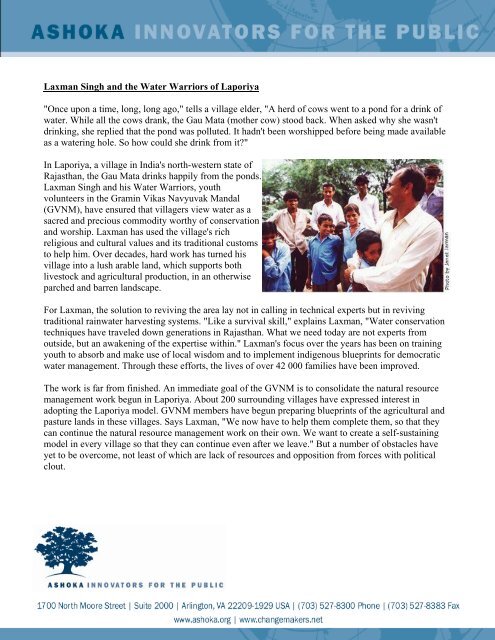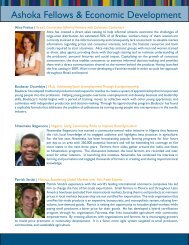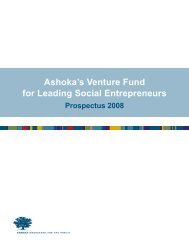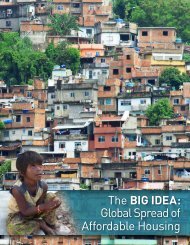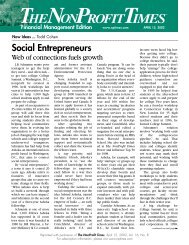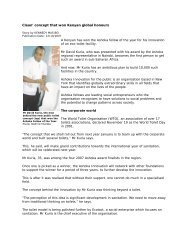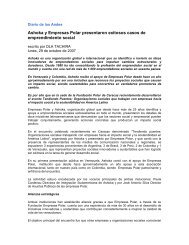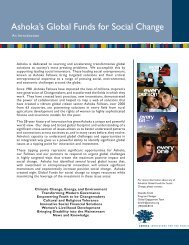Laxman Singh and the Water Warriors of Laporiya "Once ... - Ashoka
Laxman Singh and the Water Warriors of Laporiya "Once ... - Ashoka
Laxman Singh and the Water Warriors of Laporiya "Once ... - Ashoka
Create successful ePaper yourself
Turn your PDF publications into a flip-book with our unique Google optimized e-Paper software.
<strong>Laxman</strong> <strong>Singh</strong> <strong>and</strong> <strong>the</strong> <strong>Water</strong> <strong>Warriors</strong> <strong>of</strong> <strong>Laporiya</strong><br />
"<strong>Once</strong> upon a time, long, long ago," tells a village elder, "A herd <strong>of</strong> cows went to a pond for a drink <strong>of</strong><br />
water. While all <strong>the</strong> cows drank, <strong>the</strong> Gau Mata (mo<strong>the</strong>r cow) stood back. When asked why she wasn't<br />
drinking, she replied that <strong>the</strong> pond was polluted. It hadn't been worshipped before being made available<br />
as a watering hole. So how could she drink from it?"<br />
In <strong>Laporiya</strong>, a village in India's north-western state <strong>of</strong><br />
Rajasthan, <strong>the</strong> Gau Mata drinks happily from <strong>the</strong> ponds.<br />
<strong>Laxman</strong> <strong>Singh</strong> <strong>and</strong> his <strong>Water</strong> <strong>Warriors</strong>, youth<br />
volunteers in <strong>the</strong> Gramin Vikas Navyuvak M<strong>and</strong>al<br />
(GVNM), have ensured that villagers view water as a<br />
sacred <strong>and</strong> precious commodity worthy <strong>of</strong> conservation<br />
<strong>and</strong> worship. <strong>Laxman</strong> has used <strong>the</strong> village's rich<br />
religious <strong>and</strong> cultural values <strong>and</strong> its traditional customs<br />
to help him. Over decades, hard work has turned his<br />
village into a lush arable l<strong>and</strong>, which supports both<br />
livestock <strong>and</strong> agricultural production, in an o<strong>the</strong>rwise<br />
parched <strong>and</strong> barren l<strong>and</strong>scape.<br />
For <strong>Laxman</strong>, <strong>the</strong> solution to reviving <strong>the</strong> area lay not in calling in technical experts but in reviving<br />
traditional rainwater harvesting systems. "Like a survival skill," explains <strong>Laxman</strong>, "<strong>Water</strong> conservation<br />
techniques have traveled down generations in Rajasthan. What we need today are not experts from<br />
outside, but an awakening <strong>of</strong> <strong>the</strong> expertise within." <strong>Laxman</strong>'s focus over <strong>the</strong> years has been on training<br />
youth to absorb <strong>and</strong> make use <strong>of</strong> local wisdom <strong>and</strong> to implement indigenous blueprints for democratic<br />
water management. Through <strong>the</strong>se efforts, <strong>the</strong> lives <strong>of</strong> over 42 000 families have been improved.<br />
The work is far from finished. An immediate goal <strong>of</strong> <strong>the</strong> GVNM is to consolidate <strong>the</strong> natural resource<br />
management work begun in <strong>Laporiya</strong>. About 200 surrounding villages have expressed interest in<br />
adopting <strong>the</strong> <strong>Laporiya</strong> model. GVNM members have begun preparing blueprints <strong>of</strong> <strong>the</strong> agricultural <strong>and</strong><br />
pasture l<strong>and</strong>s in <strong>the</strong>se villages. Says <strong>Laxman</strong>, "We now have to help <strong>the</strong>m complete <strong>the</strong>m, so that <strong>the</strong>y<br />
can continue <strong>the</strong> natural resource management work on <strong>the</strong>ir own. We want to create a self-sustaining<br />
model in every village so that <strong>the</strong>y can continue even after we leave." But a number <strong>of</strong> obstacles have<br />
yet to be overcome, not least <strong>of</strong> which are lack <strong>of</strong> resources <strong>and</strong> opposition from forces with political<br />
clout.
Background<br />
Rajasthan is a semi-arid <strong>and</strong> drought-prone state situated in at <strong>the</strong> edge <strong>of</strong> <strong>the</strong> Thar desert <strong>of</strong> western<br />
India. Historically, communities in this state controlled <strong>the</strong>ir resources independently, <strong>and</strong> developed a<br />
range <strong>of</strong> community specific water management models. Under <strong>the</strong> feudal system, l<strong>and</strong>lords controlled<br />
large tracts <strong>of</strong> l<strong>and</strong>, some <strong>of</strong> which was leased to villagers for a range <strong>of</strong> uses. Agricultural l<strong>and</strong> was<br />
restricted, <strong>and</strong> <strong>the</strong> majority <strong>of</strong> <strong>the</strong> population maintained large herds <strong>of</strong> cattle. As <strong>the</strong> l<strong>and</strong> was under<br />
direct control <strong>of</strong> <strong>the</strong> l<strong>and</strong>lord, it was reasonably well managed. For instance, forests were protected for<br />
game, pastures were developed to maintain <strong>the</strong> herd, <strong>and</strong> water was harvested <strong>and</strong> conserved to sustain<br />
<strong>the</strong> population. L<strong>and</strong>lords were also responsible for <strong>the</strong> welfare needs <strong>of</strong> <strong>the</strong> villagers.<br />
After independence, India's l<strong>and</strong> was distributed among <strong>the</strong> people according to <strong>the</strong> tenets <strong>of</strong> socialism.<br />
Pastures <strong>and</strong> uncultivated l<strong>and</strong> were designated as village common l<strong>and</strong>s, but were soon invaded<br />
illegally. Mismanagement <strong>and</strong> degradation ensued. As l<strong>and</strong> was freed up, many villagers sold <strong>the</strong>ir cattle<br />
<strong>and</strong> switched to cultivation. Local control <strong>and</strong> management <strong>of</strong> water <strong>and</strong> forests was lost <strong>and</strong> passed into<br />
<strong>the</strong> h<strong>and</strong>s <strong>of</strong> central government bureaucrats.<br />
<strong>Water</strong> resources were brought under <strong>the</strong> control <strong>of</strong> a public water supply system managed by central<br />
government. Traditional community structures broke down <strong>and</strong> conflict over water <strong>and</strong> o<strong>the</strong>r resources<br />
occurred along caste lines. Wells fell into disrepair <strong>and</strong> villagers were hard-pressed to get enough water<br />
for <strong>the</strong>ir day-to-day domestic needs, let alone for <strong>the</strong> growing amount <strong>of</strong> l<strong>and</strong> under cultivation. Urban<br />
migration became a growing trend.<br />
Growing up in <strong>Laporiya</strong>, <strong>Laxman</strong> witnessed his once green village turning into barren pasturel<strong>and</strong>.<br />
Already drought-prone, <strong>the</strong> area's water problems were exacerbated by lack <strong>of</strong> maintenance <strong>of</strong> existing<br />
water ponds. Shortly after independence, <strong>the</strong> village's lifeline <strong>and</strong> only irrigation reservoir, Ann Sagar,<br />
broke its embankments during heavy rain. It remained broken for over twenty years. <strong>Laporiya</strong>'s water<br />
problems worsened over <strong>the</strong> next four decades as water wells dried up. <strong>Laxman</strong> explains, "In spite <strong>of</strong><br />
<strong>the</strong>re being rain, it was like <strong>the</strong> l<strong>and</strong> was absolutely dry. There was no moisture in <strong>the</strong> soil. The entire<br />
water would flow out <strong>of</strong> <strong>the</strong> village� into <strong>the</strong> river." By <strong>the</strong> late 1970s, government records described<br />
<strong>Laporiya</strong> as barren with highly saline l<strong>and</strong>scapes <strong>and</strong> denuded pasturel<strong>and</strong>s, capable <strong>of</strong> producing only<br />
one low-value monsoon crop. During summer months, 40 percent <strong>of</strong> <strong>the</strong> population migrated to <strong>the</strong><br />
cities in search <strong>of</strong> jobs <strong>and</strong>, due to lack <strong>of</strong> fodder some 75 percent <strong>of</strong> livestock was moved to nearby<br />
states. By 1991, two reservoirs in <strong>the</strong> village were silted up <strong>and</strong> <strong>the</strong> water level in <strong>the</strong> irrigation <strong>and</strong><br />
drinking water wells were some 60 feet below <strong>the</strong> surface.<br />
Whilst some areas in India were experiencing a <strong>the</strong> "Green Revolution," <strong>Laporiya</strong>, a village <strong>of</strong> 189<br />
families, remained forgotten like many o<strong>the</strong>r areas in <strong>the</strong> corners <strong>of</strong> India. Development in Nor<strong>the</strong>rn<br />
India was aided by <strong>the</strong> introduction <strong>of</strong> new canals <strong>and</strong> irrigation networks plus high-yielding seeds <strong>and</strong><br />
technology-aided methods <strong>of</strong> farming. Rajasthan too benefited from a network <strong>of</strong> irrigation canals<br />
originating at what became known as <strong>the</strong> Indira G<strong>and</strong>hi Canal. But in 1975, <strong>Laxman</strong>, <strong>the</strong>n age 18,<br />
returned from school in <strong>the</strong> city <strong>of</strong> Jaipur, to find his village on <strong>the</strong> verge <strong>of</strong> starvation.<br />
<strong>Laxman</strong> traces his roots to <strong>the</strong> ancient Rajput royal family <strong>of</strong> Jaipur. His ancestors were rulers <strong>of</strong><br />
<strong>Laporiya</strong>; after Independence in 1947, <strong>the</strong>y voluntarily relinquished <strong>the</strong>ir claims to a large portion <strong>of</strong><br />
<strong>the</strong>ir l<strong>and</strong>s in <strong>the</strong> village. But for <strong>Laxman</strong>, feudal responsibilities were hard to forget. He decided to
forgo a formal education <strong>and</strong> to devote his life to resurrecting <strong>the</strong> fortunes <strong>of</strong> <strong>the</strong> village. He began by<br />
organizing volunteers in his <strong>and</strong> neighboring villages to take turns in tilling each o<strong>the</strong>r's fields.<br />
Says <strong>Laxman</strong>, "When a village starts becoming poor, money lenders <strong>and</strong> o<strong>the</strong>r vested interests from <strong>the</strong><br />
towns <strong>and</strong> cities start buying l<strong>and</strong> from <strong>the</strong> village because <strong>the</strong> people are already poor <strong>and</strong> want to sell<br />
<strong>of</strong>f <strong>the</strong>ir l<strong>and</strong>. We started feeling that why should this happen to something that is ours, <strong>and</strong> why should<br />
we give away our l<strong>and</strong> to o<strong>the</strong>rs?" <strong>Laxman</strong> continues, "If <strong>the</strong> village survives, everything else will<br />
survive but if <strong>the</strong> village doesn't, nothing will."<br />
Mobilizing <strong>the</strong> Community<br />
Careful observation <strong>of</strong> conditions in <strong>the</strong> village led <strong>Laxman</strong> to declare, "The main problem <strong>of</strong> <strong>the</strong> village<br />
was drought <strong>and</strong> lack <strong>of</strong> water. The main cause for <strong>the</strong> situation deteriorating so much is because people<br />
were not giving proper attention; <strong>the</strong>y did not know how to conserve <strong>the</strong> water. There was nobody to<br />
guide <strong>the</strong>m."<br />
<strong>Laxman</strong>, assisted by a friend <strong>and</strong> <strong>the</strong> village priest, began to repair <strong>the</strong> embankment around Ann Sagar,<br />
which had remained broken for 25 years. Realizing <strong>the</strong>y were going to need more help to complete <strong>the</strong><br />
task, <strong>the</strong>y convened a village meeting. "We told people, 'Here is this pond that has broken, <strong>and</strong> ei<strong>the</strong>r we<br />
are going to rebuild <strong>the</strong> pond or leave <strong>the</strong> village.' We told <strong>the</strong> people that we have worked today, <strong>and</strong><br />
said, 'Please all <strong>of</strong> you come <strong>and</strong> cooperate with us.'"<br />
A few days later 30 villagers volunteered for <strong>the</strong> work. After a week ano<strong>the</strong>r meeting was convened at<br />
which villagers were asked "Are you not concerned with your own village?" <strong>Laxman</strong> estimated that 60<br />
people were needed to work every day on rebuilding <strong>the</strong> embankments <strong>of</strong> <strong>the</strong> pond <strong>and</strong> he succeeded in<br />
making this a reality. "We created an atmosphere. We worked <strong>and</strong> we told o<strong>the</strong>rs <strong>the</strong>y should cooperate<br />
with us, <strong>and</strong> <strong>the</strong>y told o<strong>the</strong>rs, <strong>and</strong> this is how we created <strong>the</strong> whole atmosphere."<br />
After this was completed, more meetings were held <strong>and</strong> a decision was taken to raise <strong>the</strong> l<strong>and</strong> around <strong>the</strong><br />
pond by two meters. In less than a year, <strong>the</strong> entire village had begun to volunteer <strong>and</strong> take part in<br />
planning a comprehensive model <strong>of</strong> water management that went much beyond <strong>the</strong> repair <strong>and</strong><br />
construction <strong>of</strong> its ponds to include irrigation <strong>of</strong> <strong>the</strong> 300 hectares <strong>of</strong> l<strong>and</strong> that <strong>the</strong> villagers owned<br />
collectively. As irrigation improved, so did <strong>the</strong> harvests.<br />
The work needed to restore <strong>the</strong> water resources <strong>of</strong> <strong>Laporiya</strong> involved repairing broken embankments,<br />
repairing existing percolation tanks <strong>and</strong> de-silting community ponds. <strong>Laxman</strong> spent a great deal <strong>of</strong><br />
energy in mobilizing rural youth, in eliciting voluntary contributions <strong>and</strong> in creating village councils to<br />
manage rejuvenated structures. Within a short time, <strong>the</strong> dramatic impact <strong>of</strong> <strong>the</strong> work had spread to<br />
nearly 40 villages eclipsing <strong>the</strong> <strong>of</strong>ficial classification <strong>of</strong> <strong>the</strong> region as 'drought-prone.'<br />
It was <strong>Laxman</strong>'s gr<strong>and</strong>fa<strong>the</strong>r, <strong>the</strong> original benevolent ruler, who had first started <strong>the</strong> work <strong>of</strong> excavating<br />
tanks <strong>and</strong> wells in <strong>the</strong> village. <strong>Laxman</strong> felt that his royal lineage gave him a responsibility to <strong>the</strong> village.<br />
It also worked in his favor when it came to mobilizing <strong>the</strong> community. <strong>Laxman</strong> explains, "When I<br />
started going out on my own with a spade <strong>and</strong> shovel to repair <strong>the</strong> only existing talaab (tank), which had<br />
been breached, people joined me because <strong>the</strong>y felt beholden to help <strong>the</strong>ir Raja (King). When I started<br />
repairing <strong>the</strong> talaab, <strong>the</strong> villagers thought it was blasphemy that I should be doing this menial work, but I
welcomed it. The numbers gradually swelled until <strong>the</strong> entire village was involved. Caste system lines<br />
have also blurred due to this culture <strong>of</strong> volunteerism <strong>and</strong> a common goal."<br />
"Our philosophy," says <strong>Laxman</strong>, "is that whatever work has to be done, it has to involve <strong>the</strong> people. The<br />
people must contribute to that work. The people should feel that we are self-made, in <strong>the</strong> sense that we<br />
have developed our village through our own efforts." But <strong>the</strong> restoration process did not go<br />
unchallenged. Opposition came from those who had illegally encroached upon pasturel<strong>and</strong>, taking<br />
advantage <strong>of</strong> <strong>the</strong> fact that local structures had broken down. No structure in <strong>the</strong> village had <strong>the</strong> authority<br />
to evict <strong>the</strong>m as <strong>the</strong> traditional institution <strong>of</strong> village governance, <strong>the</strong> panchayat (a democratically elected<br />
council <strong>of</strong> five) had fallen into disuse. In response to this absence <strong>of</strong> authority, Gram Samitis, or village<br />
councils were set up by villages, <strong>and</strong> a people-centered system <strong>of</strong> governance <strong>and</strong> decision-making was<br />
established. <strong>Once</strong> <strong>the</strong> village councils had established <strong>the</strong>ir authority, <strong>the</strong>y began to organize villagers<br />
around <strong>the</strong> tradition <strong>of</strong> shramdaan, or volunteer community labor.<br />
Mobilizing <strong>the</strong> Youth<br />
Harnessing <strong>the</strong> energy <strong>of</strong> rural youth has been critical to <strong>Laxman</strong>'s success. Over <strong>the</strong> years, <strong>Laxman</strong> has<br />
established over thirty Yuva M<strong>and</strong>als, or voluntary youth associations in surrounding villages <strong>and</strong> <strong>the</strong>se<br />
volunteers came to be known as Jal Jodhas or <strong>Water</strong> <strong>Warriors</strong>. The spirit <strong>of</strong> voluntarism encouraged by<br />
<strong>Laxman</strong> was formalized in 1986 when he formed <strong>the</strong> "New Youth Village Welfare Association," or<br />
Gramin Vikas Navyuvak M<strong>and</strong>al (GVNM).<br />
The GVNM has grown into an organization with 40 full-time workers, 8 000 volunteers <strong>and</strong> an annual<br />
budget <strong>of</strong> 4.5 million Rupees (US$93,000) funded mainly from CAPART, a quasi-governmental body,<br />
<strong>and</strong> <strong>the</strong> government's Social Welfare Board. <strong>Laxman</strong> recognized <strong>the</strong> importance <strong>of</strong> getting control back<br />
into local h<strong>and</strong>s <strong>and</strong> <strong>the</strong> water management systems he developed have been built <strong>and</strong> largely financed<br />
by residents. Each family voluntarily contributes 100 rupees towards each new project as well as<br />
volunteering labor on a rotating basis. Those who cannot contribute money contribute more <strong>of</strong> <strong>the</strong>ir own<br />
labor during <strong>the</strong> three months after <strong>the</strong> first harvest, May to July. The Village councils oversee <strong>the</strong><br />
maintenance <strong>of</strong> water resources <strong>and</strong> <strong>the</strong>y are supported in this work by networks <strong>of</strong> youth who have<br />
been trained to provide technical assistance.<br />
The GVNM are involved in a number <strong>of</strong> projects ranging from promoting reforestation to increasing<br />
crop yields <strong>and</strong> protecting water resources. Strict fines are imposed against <strong>the</strong> cutting <strong>of</strong> trees <strong>and</strong>, in<br />
<strong>the</strong> beginning, each family was asked to plant at least five trees on <strong>the</strong>ir l<strong>and</strong>. With <strong>the</strong> help <strong>of</strong> <strong>the</strong><br />
GVNM, over a million saplings have been planted in <strong>Laporiya</strong> <strong>and</strong> surrounding villages <strong>and</strong> forests have<br />
been developed for fuel. Indirectly <strong>the</strong>y have had an impact on living st<strong>and</strong>ards <strong>and</strong> levels <strong>of</strong> crime. Says<br />
<strong>Laxman</strong>, "Where we have not worked, half <strong>the</strong> village's resources go towards curbing crime."<br />
The Road To Livelihood<br />
Through <strong>the</strong> late 70's <strong>and</strong> into <strong>the</strong> early 90's, <strong>Laxman</strong> laid a firm foundation for a process he calls "<strong>the</strong><br />
road to livelihood," which became, in effect, a comprehensive community-based natural resource<br />
management strategy. "In <strong>the</strong> olden days," says <strong>Laxman</strong>, "There was no need for such resource<br />
management. There was less population <strong>and</strong> more cattle wealth. One tank (water reservoir or pond)<br />
sufficed, <strong>and</strong> cattle dung fertilized <strong>the</strong> l<strong>and</strong>. People lived simpler lives close to nature <strong>and</strong> drew on
practical traditional knowledge." But by <strong>the</strong> early 1990s, drought <strong>and</strong> an increased population had led to<br />
an acute shortage <strong>of</strong> water for drinking <strong>and</strong> agriculture. Cattle were dropping dead like flies. The old<br />
wells were dry, <strong>and</strong> those that still worked were insufficient for <strong>the</strong> village's needs.<br />
When designing solutions to local problems, <strong>Laxman</strong>'s approach has always been to draw on local<br />
wisdom. In developing a water harvesting system he relied on <strong>the</strong> indigenous knowledge <strong>and</strong> traditional<br />
skills <strong>of</strong> gajdharis (indigenous engineers <strong>and</strong> experts in l<strong>and</strong> <strong>and</strong> water conservation). It is after all, <strong>the</strong>se<br />
gaidharis that underst<strong>and</strong> <strong>the</strong> l<strong>and</strong>, its percolation rate, its slope, <strong>the</strong> rainfall pattern, its flow <strong>and</strong> its<br />
recharge rate. <strong>Laxman</strong> <strong>and</strong> his village volunteers have combined simple techniques for tapping every<br />
water route <strong>and</strong> pathway <strong>of</strong> human liquid wastes in a village - diverting <strong>the</strong>m through <strong>the</strong> village's<br />
natural watershed, directly to agricultural plots <strong>and</strong> pasture l<strong>and</strong>. Villagers, who underst<strong>and</strong> <strong>the</strong> terrain<br />
best, construct <strong>the</strong> diversions through simple conduits like canals, spillways <strong>and</strong> aqueducts. These efforts<br />
are carefully planned, monitored, <strong>and</strong> linked to <strong>the</strong> reverence villagers have for water.<br />
<strong>Laporiya</strong>'s l<strong>and</strong> <strong>and</strong> water conservation system is an integrated <strong>and</strong> multi-pronged approach that relies<br />
on local participation at every step. The 'Road to Livelihood' concentrates on all aspects <strong>of</strong> village life<br />
from animal husb<strong>and</strong>ry, to protecting <strong>the</strong> ecosystem, to water conservation <strong>and</strong> agriculture. <strong>Laxman</strong><br />
explains <strong>the</strong> approach thus, "When we work in <strong>the</strong> village, we are utilizing <strong>the</strong> entire l<strong>and</strong> <strong>of</strong> <strong>the</strong> village.<br />
Maybe on one piece <strong>of</strong> <strong>the</strong> l<strong>and</strong> we are concentrating on irrigation. On ano<strong>the</strong>r piece <strong>of</strong> l<strong>and</strong> we might<br />
develop it as a pasturel<strong>and</strong>. On ano<strong>the</strong>r piece <strong>of</strong> l<strong>and</strong>, we might do something that will improve <strong>the</strong><br />
ecology. The government, it will just take one piece or one area <strong>of</strong> <strong>the</strong> l<strong>and</strong> <strong>and</strong> try to concentrate on it."<br />
<strong>Laxman</strong> traveled to nearby areas to study water-harvesting systems. He also studied community<br />
development under <strong>the</strong> guidance <strong>of</strong> Rajinder <strong>Singh</strong>, <strong>the</strong> 2001 Magsaysay Award winner for his work on<br />
water management systems. In 1991, <strong>Laxman</strong> <strong>and</strong> his <strong>Water</strong> <strong>Warriors</strong> began to revive <strong>the</strong> village's water<br />
harvesting systems. "I felt that my village had to overcome <strong>the</strong> crisis," <strong>Laxman</strong> said, so he began digging<br />
50 new wells <strong>and</strong> three large natural tanks. Says <strong>Laxman</strong>, "The number <strong>of</strong> tanks excavated in our village<br />
<strong>and</strong> surrounding areas in 1991 alone was worth 2.5 million rupees (US$52,000)."<br />
He also introduced a unique dyke system to capture rainwater in pasturel<strong>and</strong>s. The latter has been hailed<br />
by some as an astounding feat <strong>of</strong> indigenous engineering <strong>and</strong> has ensured that this once-arid village will<br />
never fall short <strong>of</strong> water. This water harvesting technique has become known as <strong>Laporiya</strong> Squares.<br />
<strong>Laporiya</strong> Squares<br />
<strong>Water</strong> harvesting in <strong>Laporiya</strong> is important not only because <strong>the</strong> area is prone to drought but also to<br />
maintain soil salinity at levels suitable for crop production. This is because irrigation in arid areas results<br />
in <strong>the</strong> accumulation <strong>of</strong> salts in <strong>the</strong> soil unless regularly flushed. Build up <strong>of</strong> salinity can result in reduced<br />
crop yields <strong>and</strong> soil stability problems. <strong>Laxman</strong>, <strong>the</strong> <strong>Water</strong> <strong>Warriors</strong> <strong>and</strong> <strong>the</strong> village elders ingeniously<br />
introduced a technique that speaks volumes about <strong>the</strong> ecological underst<strong>and</strong>ing <strong>of</strong> <strong>the</strong> villagers.<br />
Beginning work on <strong>the</strong> near flat (1-2 % slope) community pastures on <strong>the</strong> upper reaches <strong>of</strong> <strong>the</strong> village,<br />
<strong>the</strong>y began building chaukas (squares), a system <strong>of</strong> low berms <strong>and</strong> shallow pits, to recharge <strong>the</strong> local<br />
groundwater <strong>and</strong> to regenerate <strong>the</strong> communal pasture l<strong>and</strong>. The chauka system divides <strong>the</strong> open, grassy<br />
plains into 100-hectare cells. Within each cell, <strong>the</strong> run<strong>of</strong>f is carefully managed with <strong>the</strong> system <strong>of</strong> berms<br />
to ensure that <strong>the</strong> monsoon rainwater, which comes in intense bursts, is spread over <strong>the</strong> entire area. The
zigzag pattern on <strong>the</strong> l<strong>and</strong> allows rainwater to enter <strong>the</strong> square <strong>and</strong> fill it up as per <strong>the</strong> available depth.<br />
Excess rainwater <strong>the</strong>n flows into <strong>the</strong> next square <strong>and</strong> so on. At <strong>the</strong> downhill end <strong>of</strong> <strong>the</strong> cell, <strong>the</strong> excess<br />
water collects in a tank, which is used for watering livestock. Building <strong>the</strong> berms requires moving a lot<br />
<strong>of</strong> earth, but <strong>the</strong> villagers get double-duty for <strong>the</strong>ir work by making clever use <strong>of</strong> <strong>the</strong> empty pits as well.<br />
Their shallow, flat-bottomed pits turn into micro-marshes during <strong>the</strong> monsoon season. Grasses that<br />
thrive in wet environments are seeded in <strong>the</strong> pits to maximize forage production. Differential moisture<br />
levels within a square add to <strong>the</strong> diversity <strong>of</strong> grasses that can grow within a unit area - adding to <strong>the</strong><br />
fodder harvest for <strong>the</strong> 2,900 large <strong>and</strong> small animals in <strong>the</strong> village.<br />
<strong>Laporiya</strong> Squares are a distinct departure from <strong>the</strong> conventional trenches that conservationists promote<br />
for soil conservation <strong>and</strong> moisture retention. In addition to being effective <strong>and</strong> adaptable, <strong>the</strong> squares are<br />
cost effective. In contrast to Rs.6000 per hectare <strong>of</strong> investment for <strong>the</strong> conventional system, <strong>the</strong> square<br />
system is three times less costly. "Government departments," says <strong>Laxman</strong>, "were promoting<br />
construction <strong>of</strong> trenches <strong>and</strong> contour bunding. We had seen <strong>the</strong>se <strong>and</strong> concluded (<strong>and</strong> we were right) that<br />
<strong>the</strong>se do not promote natural growth <strong>of</strong> grasses. Besides, <strong>the</strong>re are a lot <strong>of</strong> useful varieties <strong>of</strong> grass that<br />
require shallow water. They cannot survive in deep waters."<br />
<strong>Laporiya</strong> Squares, however, have yet to win recognition from experts or government agencies which<br />
continue to cast doubt over <strong>the</strong> efficacy <strong>and</strong> adaptability <strong>of</strong> <strong>the</strong> unique system. In response <strong>Laxman</strong><br />
points to <strong>the</strong> visible evidence <strong>of</strong> success. And <strong>Laporiya</strong> does indeed appear an oasis in an o<strong>the</strong>rwise arid<br />
l<strong>and</strong>scape. Interestingly, <strong>the</strong> pastures are not fenced; nor is grazing prohibited. Says <strong>Laxman</strong>, "Look at<br />
villages where we haven't worked, <strong>and</strong> you will realize. The quality <strong>of</strong> water is bad, with salinity <strong>and</strong> a<br />
concentration <strong>of</strong> minerals. There are several cases <strong>of</strong> dehydration <strong>and</strong> gastric diseases."<br />
Reviving Traditions<br />
For <strong>Laxman</strong>, reviving traditional systems for water harvesting <strong>and</strong> managing was not sufficient to<br />
prevent wastage <strong>of</strong> water, or to ensure sustained conservation. It was also necessary to leverage <strong>the</strong><br />
village's rich religious <strong>and</strong> cultural values <strong>and</strong> its traditional customs to make people underst<strong>and</strong> <strong>the</strong><br />
need to conserve water in this arid l<strong>and</strong>. Says <strong>Laxman</strong>, "I <strong>the</strong>refore placed all natural resources on a<br />
pedestal in <strong>the</strong> form <strong>of</strong> deities to preserve <strong>the</strong> sanctity <strong>of</strong> <strong>the</strong> environment."<br />
In <strong>the</strong> past, villagers had practiced reverence for life-giving water-bodies on a daily basis as well as<br />
during annual festivals. <strong>Laxman</strong> <strong>and</strong> his <strong>Water</strong> <strong>Warriors</strong> encouraged a revival <strong>of</strong> <strong>the</strong>se practices. Today,<br />
<strong>the</strong> village is dotted with small temples <strong>and</strong> fluttering commemorative flags dedicated to <strong>the</strong> guardians<br />
<strong>of</strong> <strong>the</strong> water preserves. There is a small shrine next to each little tank or well. It is dedicated to<br />
traditional Hindu gods <strong>and</strong> goddesses - primarily <strong>the</strong> mighty Shiva, who controls <strong>the</strong> cosmic cycle in his<br />
role as both creator <strong>and</strong> destroyer, or Durga, <strong>the</strong> goddess who represents <strong>the</strong> victory <strong>of</strong> good over evil,<br />
<strong>the</strong> symbol <strong>of</strong> female energy <strong>and</strong> emancipation.<br />
<strong>Laxman</strong>'s strategy has been to coordinate construction with <strong>the</strong> traditional festival season. Festivals<br />
occur in November <strong>and</strong> December. When <strong>the</strong> work on Ann Sagar began in 1990, <strong>Singh</strong> revived a<br />
traditional festival called Devudhni Igyaras, which falls on <strong>the</strong> 11th day after Diwali, <strong>the</strong> Indian festival<br />
<strong>of</strong> lights. Diwali occurs after <strong>the</strong> first harvest season is finished, <strong>and</strong> it ushers in <strong>the</strong> second season <strong>of</strong> <strong>the</strong><br />
farming calendar. Devudhni Igyaras is considered an auspicious time to initiate new activities, including<br />
<strong>the</strong> de-silting <strong>of</strong> water bodies <strong>and</strong> all o<strong>the</strong>r activities connected to <strong>the</strong> soil. There is an air <strong>of</strong> festivity in
<strong>the</strong> village on <strong>the</strong> designated day. The villagers begin a procession to <strong>the</strong> fields <strong>and</strong> pasturel<strong>and</strong>s amid<br />
much fanfare. "Behind all <strong>the</strong>se rituals is <strong>the</strong> need to conserve scarce resources ra<strong>the</strong>r than any kind <strong>of</strong><br />
religious fanaticism," <strong>Laxman</strong> says. "Reverence for natural resources is common to all religions <strong>and</strong> is<br />
woven intrinsically into <strong>the</strong> customs <strong>of</strong> <strong>the</strong> l<strong>and</strong>."<br />
<strong>Laxman</strong> <strong>and</strong> <strong>the</strong> village council have revived o<strong>the</strong>r cultural practices to protect <strong>the</strong> trees, which for <strong>the</strong><br />
villagers represent a circle <strong>of</strong> bro<strong>the</strong>rhood. In medieval times Rajasthani women were <strong>of</strong>ten prey to<br />
marauding invaders. To ensure <strong>the</strong>ir safety, women tied friendship b<strong>and</strong>s (rakhis) on <strong>the</strong> wrists <strong>of</strong> <strong>the</strong>ir<br />
bro<strong>the</strong>rs <strong>and</strong> o<strong>the</strong>r men <strong>the</strong>y thought could protect <strong>the</strong>m. <strong>Once</strong> such a string was tied, a man was bound<br />
to protect his "sister" under any circumstance <strong>and</strong> <strong>the</strong> "sister" in turn pledged to look out for his welfare<br />
anywhere, anytime. This practice was remembered in <strong>the</strong> festival <strong>of</strong> Raksha B<strong>and</strong>han ("<strong>the</strong> protective tie<br />
<strong>of</strong> bro<strong>the</strong>rhood"). This festival has been revived to stress <strong>the</strong> importance <strong>of</strong> trees in this barren<br />
environment. On Raksha B<strong>and</strong>han day, trees are anointed with tilak (a holy substance made with<br />
vermillion <strong>and</strong> s<strong>and</strong>alwood). The entire village lines up, holding a 300-foot long string, <strong>and</strong> each person<br />
takes a little bit <strong>of</strong> it to create a rakhi. The priest chants a prayer saying "All trees are our bro<strong>the</strong>rs <strong>and</strong><br />
sisters, <strong>and</strong> we vow never to kill <strong>the</strong>m." Then <strong>the</strong> villagers tie <strong>the</strong>ir strings around <strong>the</strong> trees <strong>and</strong> pledge<br />
protection. This action guards against destruction <strong>of</strong> <strong>the</strong> forest.<br />
Beyond this, <strong>the</strong> village council imposes a fine <strong>of</strong> 1,100 rupees on anybody caught cutting a tree. Instead<br />
<strong>of</strong> a fine, <strong>the</strong> violator may be told to plant two trees in place <strong>of</strong> <strong>the</strong> one he cut <strong>and</strong> to contribute five<br />
kilograms <strong>of</strong> grain to feed <strong>the</strong> birds. "The latter is better," says <strong>Laxman</strong>, "Because when <strong>the</strong>re's a<br />
question <strong>of</strong> money, corruption creeps in."<br />
Says <strong>Laxman</strong>, "Ritual <strong>and</strong> regeneration have become part <strong>of</strong> <strong>the</strong> lives <strong>of</strong> <strong>the</strong> people <strong>of</strong> <strong>Laporiya</strong> <strong>and</strong><br />
streng<strong>the</strong>n <strong>the</strong>ir belief that <strong>the</strong>y can beat <strong>the</strong> drought <strong>and</strong> never thirst for water again."<br />
Quantifying Success<br />
After <strong>Laporiya</strong>'s main tank Ann Sagar (Ocean <strong>of</strong> Grain) was restored, <strong>the</strong> villagers constructed two more<br />
percolation tanks to recharge groundwater <strong>and</strong> to supply <strong>the</strong> remaining needs <strong>of</strong> <strong>the</strong> villagers <strong>and</strong> <strong>the</strong>ir<br />
livestock. Out <strong>of</strong> reverence, <strong>the</strong>y named <strong>the</strong>m Phool Sagar ("Ocean <strong>of</strong> Flowers") <strong>and</strong> Dev Sagar ("Ocean<br />
<strong>of</strong> <strong>the</strong> Gods").<br />
Downstream from Ann Sagar, <strong>Laporiya</strong>ns grew wheat for <strong>the</strong> first time in 20 years. The amount <strong>of</strong><br />
irrigated l<strong>and</strong> area increased to 300ha out <strong>of</strong> a total <strong>of</strong> 1500ha, <strong>and</strong> <strong>the</strong> village's agricultural production<br />
increased more than 12 times. The l<strong>and</strong> that could barely support a meager rain-fed crop in <strong>the</strong> past can<br />
now produce two irrigated crops per year. Household incomes have risen from a mere Rs.500-700, to as<br />
high as Rs.17 000. In 1996 <strong>the</strong>re was a bumper harvest. Village silo bins overflowed with fodder <strong>and</strong><br />
grain. Though <strong>the</strong>se levels <strong>of</strong> harvests are difficult to sustain during low rainfall seasons, water<br />
conservation has had a lasting impact on family incomes. Even after three consecutive years <strong>of</strong> poor<br />
rainfall, increases in harvests have tripled. In 2001 <strong>Laporiya</strong> made headlines as <strong>the</strong> only village in <strong>the</strong><br />
district that did not require aid in <strong>the</strong> form <strong>of</strong> water tankers when all <strong>the</strong> surrounding villages suffered<br />
from lack <strong>of</strong> water. Despite an average rainfall <strong>of</strong> just 348mm, water levels in village wells have risen by<br />
45 feet.
The model developed by <strong>Laporiya</strong> has impacted over 90 villages in <strong>the</strong> three districts <strong>of</strong> Tonk, Jaipur<br />
<strong>and</strong> Pali. As many as 40,000 families have benefited from cultivation <strong>of</strong> 30,000 hectares <strong>of</strong> l<strong>and</strong>. And<br />
<strong>the</strong>re have been o<strong>the</strong>r sorts <strong>of</strong> benefits too. Women are being empowered by women's organizations that<br />
are springing up everywhere. They tackle issues <strong>of</strong> savings, loans, <strong>and</strong> o<strong>the</strong>r social issues such as child<br />
marriage <strong>and</strong> dowry. "There is a strong culture <strong>of</strong> volunteerism, <strong>and</strong> along with it, awareness is growing<br />
among <strong>the</strong> women," said Ramkanya Devi, leader <strong>of</strong> <strong>the</strong> women's volunteer force in <strong>the</strong> neighboring<br />
village <strong>of</strong> Avda. "They now sit in on all meetings that address village welfare issues."<br />
The GVNM has made an attempt to quantify <strong>the</strong> economic impact <strong>of</strong> its programs. Taking a control<br />
village (where no intervention has been made) <strong>and</strong> comparing it with <strong>Laporiya</strong>, GVNM has computed<br />
<strong>the</strong> economic benefits <strong>of</strong> its pasturel<strong>and</strong> development. An investment <strong>of</strong> Rs.234,029 was made to<br />
develop 350 bigha <strong>of</strong> pasturel<strong>and</strong> in <strong>Laporiya</strong> as against no investment on 280 bigha <strong>of</strong> pasturel<strong>and</strong> in<br />
village Doria. In terms <strong>of</strong> milk yield, <strong>the</strong> total income from pasturel<strong>and</strong> in <strong>Laporiya</strong> worked out to<br />
Rs.988,257 as against Rs.354,454 in Doria for <strong>the</strong> year 2000. Per bigha income from <strong>the</strong> l<strong>and</strong> was twice<br />
as much <strong>and</strong> <strong>the</strong> cost: benefit ratio <strong>of</strong> <strong>the</strong> investment in <strong>Laporiya</strong> was an impressive 1:4. In a similar<br />
vein, GVNM has begun computing <strong>the</strong> impact <strong>of</strong> its intervention on socio-economic aspects like<br />
women's empowerment, water availability, food, <strong>and</strong> fodder security.<br />
Political Challenges<br />
For two decades <strong>the</strong> GVNM has worked to rebuild social institutions. Gram Samitis (village councils)<br />
set up by <strong>the</strong> villagers <strong>the</strong>mselves in <strong>the</strong> absence <strong>of</strong> formal local authorities, have achieved enormous<br />
success in organizing communities <strong>and</strong> managing <strong>the</strong> resources <strong>of</strong> <strong>the</strong> villages. But constitutional<br />
changes <strong>and</strong> political forces threaten to undermine <strong>the</strong>se achievements. In <strong>the</strong> mid 1990's <strong>the</strong> 73rd<br />
amendment <strong>of</strong> <strong>the</strong> Constitution <strong>of</strong> India revived <strong>the</strong> panchayat system <strong>and</strong> empowered <strong>the</strong>m with<br />
administrative <strong>and</strong> financial powers to 'guide integrated development <strong>of</strong> <strong>the</strong> villages.' While <strong>the</strong> elected<br />
panchayats are <strong>the</strong> legitimate political representatives, <strong>the</strong> village councils see <strong>the</strong>ir political agendas as<br />
anti-development. Ra<strong>the</strong>r than encouraging village council members to st<strong>and</strong> for election, <strong>the</strong> GVNM<br />
has positioned itself to engage <strong>the</strong> government <strong>and</strong> o<strong>the</strong>r stakeholders in a dialogue to secure a place for<br />
<strong>the</strong> village councils in <strong>the</strong> developmental process. The GVNM is aiming to get recognition for <strong>the</strong><br />
councils to conduct developmental work for <strong>and</strong> on behalf <strong>of</strong> <strong>the</strong> panchayat.<br />
The continued success <strong>of</strong> <strong>the</strong> village councils depends on achieving <strong>of</strong>ficial status <strong>and</strong> on generating<br />
resources. Village councils do not have resources <strong>of</strong> <strong>the</strong>ir own to manage <strong>and</strong> maintain <strong>the</strong> physical<br />
structures. They rely on villages reinvesting a portion <strong>of</strong> <strong>the</strong> harvest with <strong>the</strong> councils so that <strong>the</strong>y have<br />
<strong>the</strong> resources to ward <strong>of</strong>f unforeseen exigencies such as a breach in <strong>the</strong> water tank. Not only does this<br />
reinvestment ensure sustainability <strong>of</strong> <strong>the</strong> <strong>Laporiya</strong> system, but also cushions <strong>the</strong> community as a whole<br />
against food <strong>and</strong> fodder insecurity in <strong>the</strong> event <strong>of</strong> drought. But even this source <strong>of</strong> income is under threat<br />
as <strong>the</strong> government has written to <strong>the</strong> village council objecting to <strong>the</strong> fine <strong>of</strong> 5kg <strong>of</strong> grain imposed by <strong>the</strong><br />
village council for cutting trees in village common l<strong>and</strong>s.<br />
Looking Back<br />
Through <strong>the</strong>ir work in <strong>Laporiya</strong> <strong>and</strong> surrounding villages, <strong>Laxman</strong> <strong>Singh</strong> <strong>and</strong> <strong>the</strong> GVNM have<br />
demonstrated that communities are capable <strong>of</strong> deciding what <strong>the</strong>y need to meet <strong>the</strong>ir critical need for<br />
water, <strong>and</strong> <strong>of</strong> taking appropriate action. Crucial to success is that <strong>the</strong>y perceive <strong>the</strong>ir capacity to change
<strong>the</strong> situation. Looking back, <strong>Laxman</strong> admits, "Organizing <strong>the</strong> people <strong>and</strong> motivating <strong>the</strong>m towards a<br />
common goal was tough, as <strong>the</strong> upper castes in <strong>the</strong> village had <strong>the</strong>ir own vested interests. But persistent<br />
efforts <strong>and</strong> <strong>the</strong> fact that 'seeing is believing' really motivated <strong>the</strong> entire community to make <strong>the</strong> change."<br />
One way that villagers 'see' <strong>the</strong> benefits <strong>of</strong> <strong>the</strong> system developed in <strong>Laporiya</strong> is through walking tours or<br />
Padyatras, which are organized annually by villages, to review <strong>the</strong> work <strong>of</strong> individual communities. The<br />
tours begin at <strong>Laporiya</strong> on <strong>the</strong> day marked by tradition for <strong>the</strong> worship <strong>of</strong> <strong>the</strong> ponds. Large groups <strong>of</strong><br />
young water technicians, village leaders <strong>and</strong> o<strong>the</strong>r villagers travel to over 80 villages reviving <strong>the</strong> oral<br />
traditions <strong>of</strong> water management <strong>and</strong> encouraging re-greening. These walkathons play an important role<br />
in reviewing <strong>and</strong> critiquing <strong>the</strong> plans <strong>and</strong> decisions made by individual villages regarding l<strong>and</strong> use <strong>and</strong><br />
resource management.<br />
And what <strong>the</strong>y see is enough to convince <strong>the</strong>m <strong>of</strong> <strong>the</strong> success <strong>of</strong> <strong>the</strong>ir approach. <strong>Water</strong> is stored in a<br />
network <strong>of</strong> community ponds, lakes <strong>and</strong> ear<strong>the</strong>n percolation reservoirs. Peacocks <strong>and</strong> jungle fowl run<br />
free throughout <strong>Laporiya</strong>, darting in <strong>and</strong> out <strong>of</strong> <strong>the</strong> fields <strong>and</strong> vegetable patches. Deer <strong>and</strong> nilgai (<strong>the</strong><br />
largest Asian antelope) roam <strong>the</strong> pasturel<strong>and</strong>s alongside goats, sheep, bullocks (oxen used for plowing),<br />
<strong>and</strong> cows. In <strong>Laporiya</strong>, even <strong>the</strong> birds are not forgotten. Flocks <strong>of</strong> pigeons, parrots <strong>and</strong> o<strong>the</strong>r local<br />
species swoop down on raised feeding platforms that have been built for <strong>the</strong>m atop <strong>the</strong> granaries. "If we<br />
have enough grain, we must make sure <strong>the</strong>y do too," <strong>Singh</strong> said, as he points to water <strong>and</strong> fodder troughs<br />
built especially for animals <strong>and</strong> birds at certain locations in <strong>the</strong> village.<br />
Says Ramjilal, head <strong>of</strong> <strong>the</strong> environmental program in <strong>the</strong> neighboring village <strong>of</strong> Sitapura, "After <strong>Laxman</strong><br />
<strong>and</strong> his volunteers came to our village <strong>and</strong> explained everything, we formed our own village water<br />
management committee. In <strong>the</strong> past year, we have dug three tanks, built temples <strong>and</strong> shrines along <strong>the</strong>m,<br />
<strong>and</strong> repaired wells. There has been a 50 percent increase in our agricultural output." Having seen success<br />
spreading to o<strong>the</strong>r villages, as many as 200 o<strong>the</strong>r villages in Rajasthan are collecting funds to follow <strong>the</strong><br />
<strong>Laporiya</strong> experience. The GVNM are assisting with testing design components <strong>and</strong> drawing up<br />
blueprints <strong>of</strong> agricultural <strong>and</strong> pastoral l<strong>and</strong>s.<br />
<strong>Laxman</strong> looks back proudly on his achievements. Explaining his motivation, he says, "I feel that if I left<br />
<strong>Laporiya</strong> - if I ever decided to settle in Jaipur, or some big city, <strong>the</strong>n my life would be so stereotyped. I<br />
would be running after materialistic needs. I feel that if I can do something that will give this village all<br />
that it needs - water, food, <strong>the</strong>n I don't need anything else. I derive a great sense <strong>of</strong> satisfaction from<br />
this."<br />
Having set up a system <strong>of</strong> mutual interdependence <strong>and</strong> empowering <strong>the</strong> village councils through<br />
continuous nurturing <strong>and</strong> exposure to innovative ideas, <strong>Laxman</strong> has stepped aside. Responsibility for<br />
carrying forward <strong>the</strong> work is vested in <strong>the</strong> village councils, which have moved to <strong>the</strong> next stage <strong>of</strong><br />
decision-making <strong>and</strong> control <strong>of</strong> resources, supported still by <strong>the</strong> GVNM. But political forces continue to<br />
act against <strong>the</strong> vulnerable in <strong>the</strong> village <strong>and</strong> <strong>the</strong> administrative machinery keeps a close watch on <strong>the</strong><br />
functioning <strong>of</strong> <strong>the</strong> village councils, as <strong>the</strong>y continue to play an important role in supporting <strong>the</strong> work <strong>of</strong><br />
resource management in <strong>Laporiya</strong> <strong>and</strong> o<strong>the</strong>r villages. They have yet to receive formal recognition, in <strong>the</strong><br />
absence <strong>of</strong> which <strong>the</strong>y receive no government funding. Whilst <strong>the</strong>y continue to rely on voluntary<br />
contributions from villagers, long-term sustainability depends on <strong>the</strong>ir ability to tap into o<strong>the</strong>r sources <strong>of</strong><br />
financial assistance.


